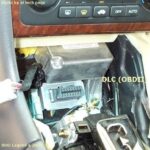A vehicle speed sensor (VSS) is a critical component in your Chevy’s engine management system. It provides real-time data to the engine control module (ECM) and transmission control module (TCM), influencing various functions like fuel injection, transmission shifting, and cruise control. A faulty or improperly wired VSS can lead to a range of issues, from inaccurate speedometer readings to poor fuel economy and even transmission problems. This article delves into the intricacies of the Chevy Obd2 Vehicle Speed Sensor Wire, focusing on troubleshooting and understanding its role in the vehicle’s overall performance.
Understanding the Chevy VSS and its Wiring
The VSS in a Chevy typically generates a pulse signal proportional to the vehicle’s speed. This signal is transmitted to the ECM and TCM via specific wires. While the exact wiring configuration might vary depending on the year, model, and engine type of your Chevy, understanding the general principles is crucial for diagnostics. The ECM utilizes the vehicle speed data for critical calculations, while the TCM uses it for proper gear shifting.
Common issues related to the Chevy OBD2 vehicle speed sensor wire include:
- Damaged Wiring: Physical damage to the wire, such as cuts, fraying, or corrosion, can disrupt the signal transmission.
- Loose Connections: A loose connection at the VSS connector or at the ECM/TCM can lead to intermittent or complete signal loss.
- Short Circuits: A short circuit in the wiring can cause erratic behavior and potentially damage the sensor or control modules.
- Incorrect Wiring: In some cases, especially with modified vehicles, the VSS wire might be connected incorrectly.
Diagnosing Chevy VSS Wire Problems
If you suspect an issue with your Chevy’s VSS wire, here’s a systematic approach to diagnose the problem:
-
Visual Inspection: Start by visually inspecting the VSS wire for any obvious signs of damage. Trace the wire from the sensor to the ECM and TCM connectors, looking for any breaks, kinks, or exposed wires.
-
Connector Inspection: Carefully examine the connectors at both ends of the VSS wire. Look for bent pins, corrosion, or loose connections. Disconnect and reconnect the connectors to ensure a secure fit.
-
Signal Testing: Using a multimeter or an oscilloscope, you can test the signal being generated by the VSS. Consult your vehicle’s wiring diagram to identify the correct pins for testing. A good VSS should produce a pulsing voltage signal that increases in frequency with vehicle speed. This step may involve backprobing the connector while turning the output shaft.
-
Continuity Testing: Use a multimeter to check for continuity in the VSS wire. This will help you identify any breaks or open circuits in the wiring.
-
OBD2 Scanner: An OBD2 scanner can be used to read diagnostic trouble codes (DTCs) related to the VSS. These codes can provide valuable clues about the nature of the problem.
Common Chevy VSS-Related DTCs
Some common DTCs that might indicate a problem with the VSS or its wiring include:
- P0500: Vehicle Speed Sensor Malfunction
- P0502: Vehicle Speed Sensor Low Input
- P0503: Vehicle Speed Sensor Intermittent/Erratic/High
The Role of Communication Between ECM and TCM
In many Chevy models, the ECM and TCM communicate and share data, including vehicle speed information. A breakdown in this communication can lead to issues even if the VSS and its wiring are functioning correctly. Verify that both modules are communicating properly using a diagnostic tool. Certain pins on the ECM, like C1 21 and C1 49, might receive speed signals. Ensuring proper communication and signal transmission between these modules is vital for accurate vehicle operation.
Conclusion
The Chevy OBD2 vehicle speed sensor wire plays a crucial role in your vehicle’s performance and drivability. Understanding its function and knowing how to diagnose related problems is essential for any Chevy owner or mechanic. By following the troubleshooting steps outlined in this article and using the appropriate diagnostic tools, you can effectively identify and resolve issues with your Chevy’s VSS wiring, ensuring accurate speed readings and optimal vehicle performance. If you’re unsure about performing these diagnostics yourself, consult a qualified automotive technician.

